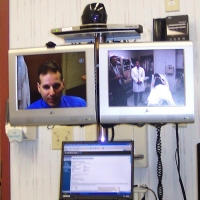NARH Teams with Mass. General Hospital for Stroke Services
 |
| Video monitors, laptop computers, and remote control cameras are the tools of a NARH/Mass. General Hospital telemedicine link. |
 |
| Video monitors, laptop computers, and remote control cameras are the tools of a NARH/Mass. General Hospital telemedicine link. |
| If you would like to contribute information on this article, contact us at info@iberkshires.com. |